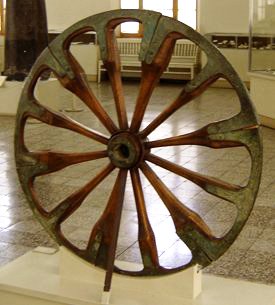The unicycle is one of the most primitive forms of transportation, dating back to cro-magnon man’s stone wheel with pegs we’ve come to call the BC wheel.
In what is known as Iran today, spokes were invented, making the wheel lighter and stronger.
Egyptians advanced the horse drawn one wheel chariot, but it was overshadowed by the two chariot. Only the affluent and god-like balanced could ride the chariot with one hand for reins and one for sword. It is said some were made of solid gold, but were later pilaged and melted down.
The big breakthru came when the Greeks discovered iron. The Greek word uni-cycle was coined, and they’d ride them naked down mount Olympus. In war, the iron unicycle could be used as a weapon.
Rome banned the unicycle, and persecution and setbacks continued into the dark age of unicycling.
It would be the renaissance before the sport resurfaced in Germany, which invented muni. The design was much like the modern unicycle, but with solid tires and an unpadded leather seat. Yodeling came about from muni riders in the Alps.
Unicycle joisting became a way to settle disputes, and introduced armour.
James Stanley brought the idea into industrial England, but found the socialite market couldn’t ride easily enough, so he added a training wheel and the penny farthing was born.
By turn of the century, riders had dispensed with the training wheel, which is where the phase “you lost a wheel” comes from. Riders were known as the fastest humans on earth. This was the heyday of unicycling, and despite improved roads, unicycles were dangerous and many accidents occurred.
Once the car & airplane overtook unicycle for transcontinental travel, the unicycle returned to sport again, much like in the Greek days. Every 4 years, the worlds best riders compete at Unicon for national glory and a chance to win gold, in events like mountain unicycling, joisting, freestyle and unicycle tossing.
 Here’s an example of how I thought this thread might go:
Here’s an example of how I thought this thread might go:

